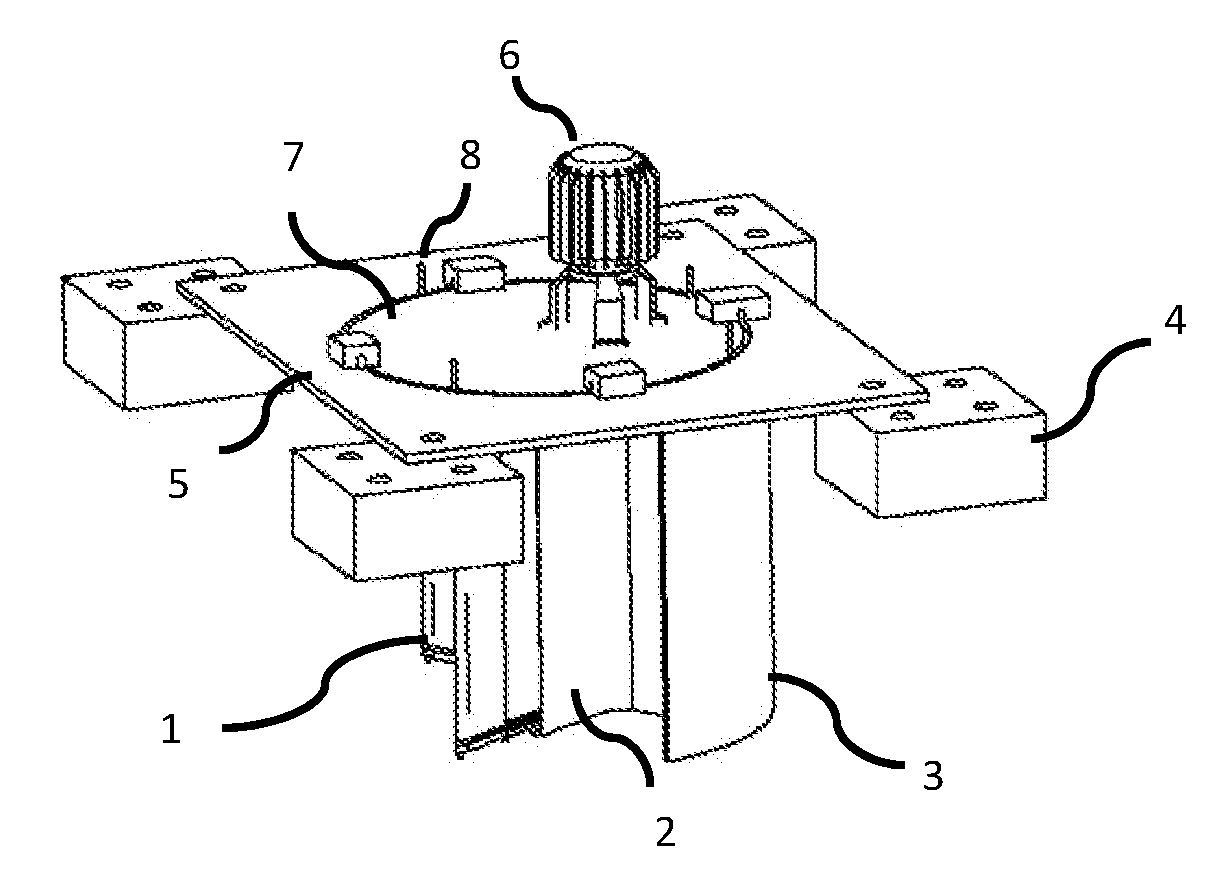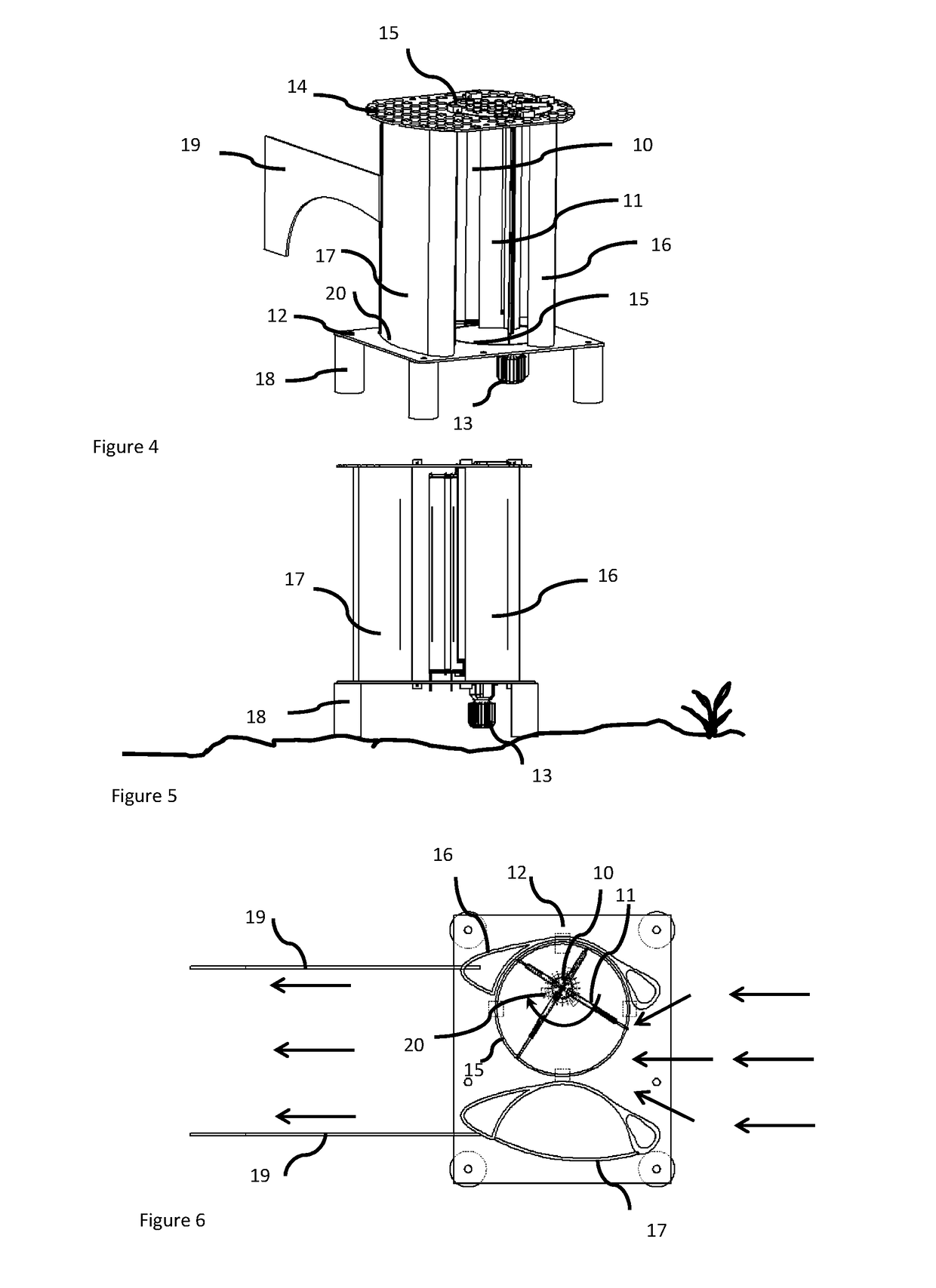Variable area blade turbine and conditioning flow deflectors device and method
a blade turbine and variable area technology, applied in the direction of machines/engines, engine components, hydropower generation, etc., can solve the problems of few economically feasible technologic alternatives, inability to connect rural communities to the interconnected system, and inability to provide electricity to rural communities. , to achieve the effect of increasing the mechanical complexity and the risk of system failure, easy stacking, and increasing the overall extended blade area
- Summary
- Abstract
- Description
- Claims
- Application Information
AI Technical Summary
Benefits of technology
Problems solved by technology
Method used
Image
Examples
first embodiment
[0089]FIG. 9 is a top view of a variable area blade turbine with only the rotor 34 of four blades 35a, 35b, 35c, 35d using the telescopic or nesting method, the blocking deflector 37, the base platform 38, and the fixed guide 36 located on a fluid flow. The rotor 34 rotates in clockwise direction as the fluid flows leftwards. The area swept by the four blades 35a, 35b, 35c and 35d attached to the rotor 34 is delimited by the circular curve in this case coincident with the fixed guide 36. There are four quadrants identified in that area, being the two quadrants limited by the curved segment DAB corresponding to the called “working region” because it is the region where the flow produce a force on the blades in the desired direction of rotation of the rotor, generating the working torque on the rotor. The two quadrants descripted by the curved segment BCD is called the “return region” in which the blades are not being moved by the flow, even receiving a force by the fluid in opposed d...
third embodiment
[0096]FIG. 14 is a cross sectional view of the variable area blade turbine showing two diametrically opposed blades using the area reorientation method. This method consists on having MBPs 64a and 64b with flat or airfoil like shape on each blade, rotating on its own longitudinal axis relative to the FBP 65a and 65b which bears their shaft in such a manner that during the pass of the blade through the “working region”, the MBPs 64a on the blade located rightwards to the spindle shaft 23, rotate to face the flow with the wider area, closing the pass of the flow between them, in a similar way to a blind curtain when it is closed to avoid the light to pass thru, maximizing the force of the fluid on that blade, and the MBP's 64b facing the flow with their thinner side, to allow the flow to pass through them, showing the blade at this point the minimal resistance to move. The movement of the MBP 64a and 64b is made by the radial displacement the followers 66a and 66b with respect to the ...
fourth embodiment
[0103]FIG. 21 is a partial plant view of the four blade rotor of the present invention as shown in FIG. 20 including the platform 101, and the fixed guides to restrain the movement of the followers, being the outer guide 102, the middle guide 103 and the inner guide 104, for each one of the respective followers 95, 96, 97 from FIG. 20. As the rotor turns, each follower displaces along its corresponding fixed guide, changing the relative distance between each pair of two consecutive followers of the same blade, and this change in distance due to the eccentricity of the fixed guides 102, 103, 104. The geometrical profile of the fixed guides may be any closed curve, preferably mathematically soft, which means each segment of the curve is tangent with its colliding segment and are continuous, being possible to have some portions of such curve as straight lines. As example of the geometrical profile of the fixed guides is shown by circular elements in the fixed guides 102, 103, 104. The ...
PUM
 Login to View More
Login to View More Abstract
Description
Claims
Application Information
 Login to View More
Login to View More - R&D
- Intellectual Property
- Life Sciences
- Materials
- Tech Scout
- Unparalleled Data Quality
- Higher Quality Content
- 60% Fewer Hallucinations
Browse by: Latest US Patents, China's latest patents, Technical Efficacy Thesaurus, Application Domain, Technology Topic, Popular Technical Reports.
© 2025 PatSnap. All rights reserved.Legal|Privacy policy|Modern Slavery Act Transparency Statement|Sitemap|About US| Contact US: help@patsnap.com



